DEEPWATER TECHNOLOGY
Independence Hub: Record after record after record...
Take all of the deepwater and subsea technological know-how to date, and apply it to a collection of otherwise sub-economic fields. The result is the world’s largest and deepest offshore hub project. Is this how the future will look?
Perry A. Fischer, Editor
On land, a 10- or 20-million-boe field would be a very good discovery. But in ultra-deepwater, such fields are sub-economic. The Independence Projects will allow five independent exploration companies to develop multiple deepwater natural gas/condensate discoveries in water depths ranging from 7,800 to 9,000 ft.
The Independence Hub (I-Hub) platform, Independence Subsea and the gas pipeline known as Independence Trail will have the capacity to gather, process and transport about 1 Bcfd of gas plus significant condensate production from 10 fields that lie in the untapped East Central Gulf of Mexico, specifically, in the Atwater Valley, Lloyd Ridge, DeSoto Canyon and Mississippi Canyon areas.
This project can be considered a collection of all-time records; a unique project in a class of its own; a sign of the times and, quite likely, a direction for the future. Oversimplified, what this project does is transform the seafloor into a more land-like analog, something that “un-strands” otherwise uneconomic fields. Independence will enable recovery of at least 2 Tcf of gas reserves. This is 10% of US gas supply from the Gulf of Mexico, or 2% of total US gas production.
Some of the fields were discovered in 2001–2003, but as 2003 progressed, it became obvious that a collection of uneconomic fields was emerging. Discussions began among five independent exploration companies in 2003; a plan was hatched with a Notice to Proceed and a FEED study was contracted. The project became public in November 2004.
PROJECT SCOPE
The Independence Project is centered 110 mi southeast of the Mississippi River Delta. It is a hub-and-spoke project on unleased Mississippi Canyon Block 920 in 2,414 m (7,920 ft) of water, making it the world’s deepest floating production and subsea tieback. Viewed as a rectangle, it covers an impressive 1,800 sq mi, Fig. 1.
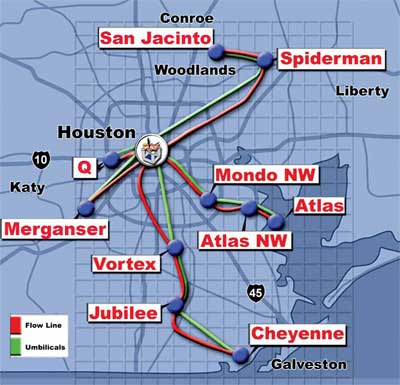 |
Fig. 1. Laid out as a rectangle, Independence Project covers 1,800 sq mi.
|
|
The Hub itself is a 105-ft deep-draft semisubmersible platform with a two-level production deck, Figs. 2 and 3. Anadarko is the Hub operator. If all goes well in the next few months, the I-Hub should be online in the July–September timeframe. That would be about six years from the Merganser field discovery to first production, and a little over four years from the first Independence agreement to first production.
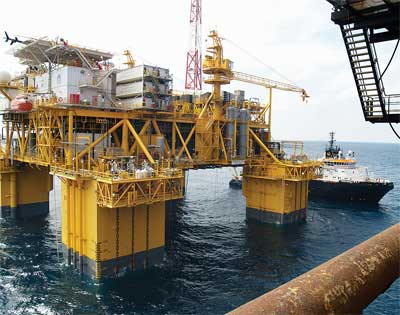 |
Fig. 2. The I-Hub in final stages of construction, March 2007.
|
|
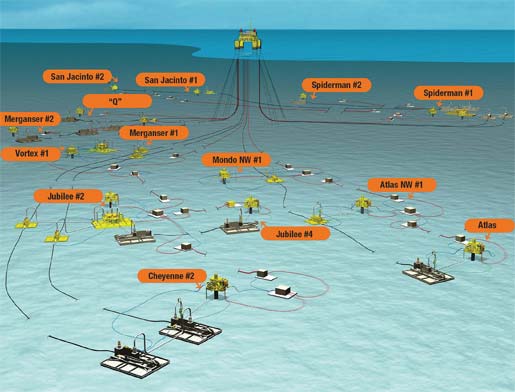 |
Fig. 3. The 10 fields that comprise the Independence Project, and the associated infrastructure. covers 1,800 sq mi.
|
|
Along with the water depth come other world superlatives: the world’s deepest suction-pile installation; world’s largest single subsea umbilical order; world’s deepest subsea structure for future pipeline inline tie-in. And because of the 1-Bcfd gas capacity in deep water, combined with the areal extent, it will need the best flow assurance possible, requiring the world’s largest monoethylene glycol (MEG) reclamation unit.
Cheyenne field will be the deepest (water depth) producing field in the world, with its subsea tree at 9,000 ft. Because the umbilicals were so long, a weight-reducing/strength-enhancing solution was needed. That solution was the replacement of steel rods with carbon fiber rods—another first in subsea umbilicals. It is also the world’s longest umbilical. Subsea umbilicals contain about 1,100 mi of steel tubing, and there are over 200 mi of 8 to 10-in. diameter of flowlines. It will be the largest gas processing facility in the Gulf of Mexico.
Steel catenary risers connect the topsides to 200 mi of 8- to 10-in. diameter flowlines that run from each wellhead to Hub. The mooring lines are polyester, similar to those at Thunder Horse, but at 2.4 mi each, they will be the world’s longest. The project will also have the world’s deepest steel catenary risers and export pipeline, originating in 8,000 ft of water. And of course, the deepest flowlines. The Hub has excess capacity to tie back up to 10 additional fields as future discoveries occur in this ultra-deepwater area.
Independence Trail, the export pipeline from the hub, will carry gas and condensate through a 61-cm (24-in.) diameter pipeline 135 mi to a fixed junction platform in the shallow water.
The discovered fields and 15 wells are shown in Fig. 3. These 10 “anchor” fields are slated to be the first onstream:
- Atlas field and Atlas NW satellite field are in Lloyd Ridge Blocks 5, 49 and 50. They were discovered in June 2003 and January 2004, respectively, and are 100% owned by Anadarko. The fields lie in nearly 9,000 ft of water.
- Jubilee field lies in Atwater Valley Blocks 305 and 349, and Lloyd Ridge Blocks 265 and 309. It was discovered in April 2003 and is 100% owned by Anadarko. The discovery well logged 83 ft of net pay and was drilled to 18,310-ft MD.
- Merganser field lies in Atwater Valley Blocks 36 and 37 in 7,900 ft of water. It was discovered in 2001 by Kerr-McGee (now merged with Anadarko), which owned 50%, and operator Devon, which owns 50%.
- Spiderman field lies in 8,100 ft of water on DeSoto Canyon Blocks 620 and 621. It was discovered in November 2003. The discovery well was drilled in 8,100 ft of water to an MD of 18,065, and encountered 140 ft of net pay. It is owned by operator Anadarko (45%), Dominion (36.67%) and Spinnaker (now part of Hydro Gulf of Mexico), 18.33%.
- San Jacinto field, in DeSoto Canyon Blocks 618 and 619, was discovered in 2004. Dominion holds 53% and is operator; Spinnaker (now Hydro GOM), 27%; and Kerr-McGee (now Anadarko), 20%. The discovery well was drilled to an MD of 15,829 ft and found about 100 ft of net gas pay in multiple sands. An appraisal was then drilled to 18,075-ft MD and had similar results. The field will be developed jointly with Spiderman.
- Vortex field, discovered in December 2002, lies in 8,345 ft of water on Atwater Valley Blocks 217 and 261 and on Lloyd Ridge Blocks 177 and 221. Anadarko merged with partner Kerr-McGee, and so now owns 100%.
- Mondo NW field was discovered in January 2005 in Lloyd Ridge Block 2 in 8,351 ft of water. Operator Anadarko has 50% stake, and Murphy Oil 50%.
- Cheyenne field lies in 8,987 ft of water on Lloyd Ridge Block 399. Discovered in January 2005, it is 100% owned by Anadarko.
- Q field lies in Mississippi Canyon Block 961 in 7,925 ft of water. The discovery well reached a 17,644-ft MD in June 2005 and encountered 110 ft of true vertical pay in a continuous, high-quality Middle Miocene reservoir. It is owned by operator Hydro GOM (50%) and Dominion (50%).
OWNERSHIP
Early on, the oil companies realized that they needed an integrated management structure as unique as the project itself. The ownership and management responsibilities of the various aspects of the Project reflect this. While an integrated project, Independence Hub, Independence Trail and Independence Subsea are three separate-but-integrated sub-projects that form the Project.
Independence Subsea is owned by the operator-producers, who will build and operate the subsea facilities from the wells to tiebacks on the I-Hub. The companies are Anadarko Petroleum, Devon Energy, Dominion Exploration & Production and Hydro Gulf Of Mexico.
Independence Hub is 80% owned by Enterprise Products Partners L.P. (EPD), with the remaining 20% owned by Helix Energy Solutions Group, Inc. (formerly Cal Dive). Anadarko will operate the Hub.
Independence Trail is 100% owned by Enterprise Products Partners L.P., which will install and operate the 135-mi pipeline (with an estimated cost of $280 million) that will re-deliver production from the Hub platform into Tennessee Gas Pipeline. Figure 4 shows the integrated management service.
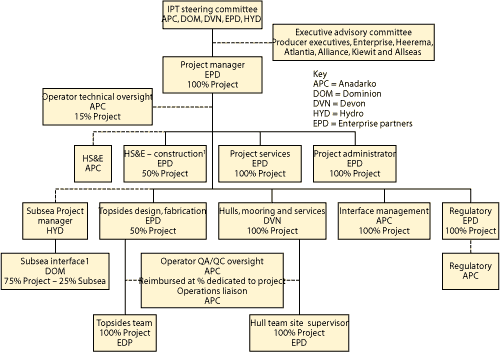 |
Fig. 4. Schematic of the unique structure of the project.
|
|
KEY CONTRACTORS
Building the project involved a lot of expertise from several key contractors, without whom it could not have been a success. For the subsea portion, contractors included Aker Kvaerner, Heerema Marine Contractors, Fig. 5, FMC Technologies, Subsea 7 and Allseas. Hub and Trail contractors included Heerema, Kiewit, Wellspun, Atlantia, Solar Turbines, SBM Offshore, Allseas and Alliance Engineering.
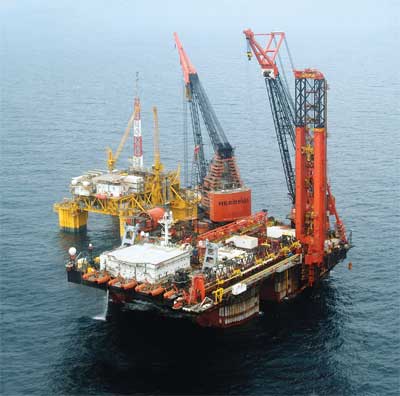 |
Fig. 5. The DCV Balder installing SCRs in March 2007. This vessel has the world�s largest capacity J-lay tower, the largest winch, and two heavy-lift cranes to get the I-Hub built.
|
|
CONCLUSION
So, if you’re an ONGC, a CNOOC, or oil company with offshore interests in deep water, this project is one that ought to make you lean forward and take notes. In deepwater areas that previously required huge discovered volumes to go along with the high costs, Independence Project is proving that the economic threshold can be dramatically lowered, provided that you can find the right management and the right contractors—all with a cooperative mindset to get the job done. 
|







